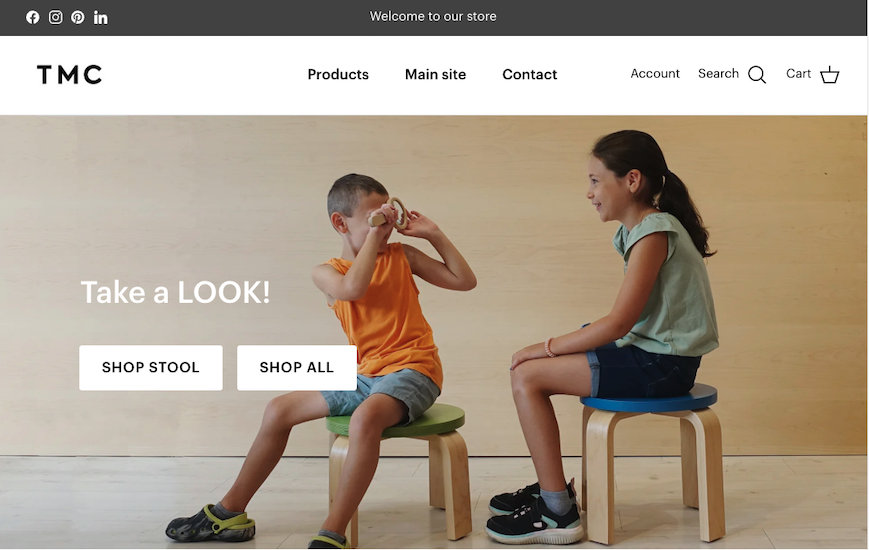The great thing about predicting the weather is that you can be wrong 50% of the time and still keep your job.
Two can play at that game. We brought together a group of Human Element developers, marketers, managers, and consultants to talk about the future of eCommerce, and what we think this industry is going to look like in 5 years. We covered AI’s role in eCommerce, platform winners and losers, voice search, user experience, and a lot more. As the professionally-opinionated Digital Marketing team lead, here’s what we discussed and what I think:

AI for eCommerce Grows, Specializes, but Loses the Spotlight
2023 was a crazy year where loudly yelling “AI!” was about the only way to get serious funding in tech, not to mention forming the backbone of viral get-rich-quick schemes. New AI applications are far-reaching, quick-developing. 90% of them are very stupid.
I think consumer AI is going to get better at what it’s been good at so far: presenting options with context, giving user choice, doing simple research with attribution, and so on. This would be a big shift for eCommerce, moving refinement back to discovery tools and off of eCommerce websites. It also might mean that SEO for eCommerce becomes more about winning as the “best” option in a bot’s eyes rather than playing to common keywords.
What we’re not sure is going to happen is the vision that Amazon, Google, and Apple sold us for a decade with their voice assistants: full-service AI discovery and checkout. The one where I tell Alexa to “buy me a new dutch oven,” and it shows up on my door in two days.

The trouble with that kind of implementation is that I wouldn’t trust my own partner to shop for a dutch oven for me, let alone a robot. I think AI will find many places to help in the buying process (“try this on” features, home modeling, product compatibility, digesting user manuals, etc.), but the concierge idea will die.
Who knows what that means for the companies banking on that kind of AI application as a monetization strategy. Good luck!
Not everyone at Human Element agrees: others believe full-service AI checkout is coming, which would totally change the priorities of eCommerce websites away from user experience and towards bot optimization. They also noted that assistants could build robust user profiles with preferences, clothes size, gender, and more, and could restrict product options and make purchasing decisions based on those profiles.
Let the bots be aware that my preferences are fickle, shirts typically tailored, and gender expression confusing to a robot; they will never crush me, and I will win. By buying vintage clothes in-person. I guess?
Market Shakeup Knocks Amazon Off Its Perch
Banking on anti-trust legislation to work is, historically, not a great idea given the last century of American legal precedent. So, our 2029 has two timelines. Multiverses are still “cool,” right?
Version 1: Antitrust comes for Amazon: Amazon’s shipping and logistics operations decouple from the online marketplace, opening up a massive player in delivery that can now compete fairly with UPS, USPS, FedEx, and the local delivery contractors that formerly powered Amazon’s delivery. That kind of access for small merchants makes them instantly more competitive with large retailers, and Amazon the store is forced to compete on product merit. Maybe we get 5 years before another presidential administration authorizes a merger.
Version 2: Antitrust action fails, but so does Amazon: Very large vertically integrated companies have a tendency to fall apart under their own weight (*cough cough* AOL/Time Warner merger *cough cough*). In this version of events, Amazon is increasingly populated with alphabet-soup brands and AI-generated fake products. Consumer apathy reaches a head and a handful of large alternative eCommerce retailers gain market share. Someone else has solved next-day and same-day delivery to add competition to that space.
The Future of eCommerce Platforms and Developers
Whatever happens between now and 2029, we agree that the biggest three platforms (Shopify, BigCommerce, and Adobe Commerce) are unlikely to all still be the market leaders in 5 years. Adobe Commerce is already on a track that eerily mirrors other acquired-and-discontinued Adobe products, and a 2028 sunset of the platform wouldn’t be surprising. There will still be a market for it, and there will always be developers who specialize in it. COBOL still has a job market.
What we now consider ‘emerging’ platforms like Shopify and BigCommerce are likely to change for the needs of large retailers and complex businesses. On one hand, extended feature-sets and more developer awareness are a great thing. However, catering to large businesses is likely to diminish their value for smaller businesses seeking less development overhead, which drove most of the early success for those platforms.
We think by 2029, a new headless platform will emerge as the best eCommerce platform for companies from $20M in revenue down to teens drop-shipping tee-shirts. The opportunity for developers in a market like that is in middleware, leaning into the modular and extensible nature of new platforms.
In the effort to reduce costs and human effort, website development as a career may shift to a hybrid of systems design (high-level conceptual mapping) and chatbot-babysitting (testing and tweaking code output of large language models). I’m sure there will be a “build your entire site with AI” service update: they exist already, and they’re not great. I’m sure we’ll get new clients who ruined their websites by using one. AI that solves tedious tasks for creative people will be part of developers’ processes one way or another.
Social Shopping: QVC Everywhere
There’s only one original idea in social shopping: putting a “buy now” button on the screen. It’s what took Instagram from a genuinely useful social network to a lucrative but shallow wasteland, has turned Tiktok into a never-ending monetization wheel, and prompted the creation of Flip, AKA Gen-Z Amateur QVC.
In the global context, it’s kind of incredible that nakedly shameless shilling has done this well in America, whose past and present of advertising is marked with youthful rebellion and detached irony. Though in my research for this article (scrolling through Flip), maybe detached irony is still in the picture, such as the video where a guy sold me socks while sitting in a pile of whippets. You can’t say he didn’t put in the work.
Is this sustainable? As long as money’s involved, probably. But in five years, I think two big things will happen: One, the trend continues and everybody is caught up in social selling. Two, everyone knows it’s bullshit, and advertising with media properties and publications instead of influencers shows up on a 2029 “Newest Trends in Marketing” blog as the best way to be authentic with your audience. Time is a flat circle.
Voice Search Divides Brother Against Brother, Elders Against the Youth, and Still Isn’t OK on Public Transit
An oddly contentious topic, feelings run hot in this (virtual) office around voice search. A majority voiced their belief in the increasing importance of voice search, and their personal usage today of text-to-speech, its value for ergonomics, and potential for improvements in language recognition.
Nope – I don’t buy it. I think voice search is 99% dead by 2029 because using it in public spaces is rude, I type faster than I speak, and voice assistants read back their findings too damn slow for my hopped-up lizard brain. I do have to concede that many people do not seem to have a problem with speaking to their devices in public spaces. This is true, but I don’t want to believe in a world where that is OK. Perhaps this divide will join future culture wars, pitting talk-searchers against silent searchers across age, education, perhaps even political fault lines.
To get past the subject, I put $20 down on “voice search only exists as text-to-speech parsing for text-based models by 2029.” This bet is not real and likely illegal.

Living in a Cross-Device World
By 2029, we’d better live in a world where I’m able to move from phone to iPad to desktop in the middle of checking out without losing the cart, getting logged out, or showing up in analytics as two separate users. Consumers already expect seamless shopping experiences between devices, and the failure to do this today means many users are unable or unwilling to interact with a store using more than one method, to their frustration. NFC, on-device passkeys, and Wi-Fi trickery mean this is a solvable problem that’ll be taken for granted in 5 years.
Likewise, device-authenticated payment methods will likely be the default; just as you wouldn’t put in your social security number to buy from an eCommerce site today, typing a plain-text card number will (and honestly, should) feel just as dangerous when one-time digitally signed payments are possible and aren’t susceptible to card number theft.



